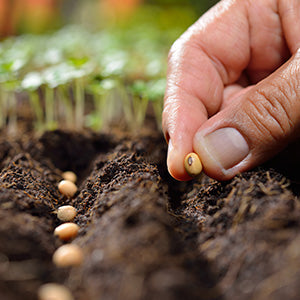Gluten-Free, Vegan Chocolate Chip Cookie Recipe

These double chocolate chip cookies are not your average cookie. For one, there’s no flour, refined sugar, or processed oils in this seven-ingredient recipe. The best part is that they actually taste good! Some gluten-free, vegan recipes are hit-or-miss. A lot of them just taste bland. These do not — they taste delicious and have a decadent texture. The combination of almond butter and cocoa powder produce the dense, soft, chewy consistency that double chocolate chip cookies are known to have. If you’re preparing these for an event, don’t forget to taste one when they’re fresh out the oven — the center is still a little gooey while the edges are lightly crisp.
For this recipe, you’ll need the new, vegan egg-replacer: “aquafaba.” It sounds exotic, but it’s probably something you unknowingly throw out if you ever eat chickpeas.
What Is Aquafaba and How Can You Use It?
Aquafaba is the viscous brine left behind after boiling chickpeas. If you buy canned chickpeas, it's the water or juice many recipes instruct you to drain off. Save this liquid next time you make hummus; it’s an incredible egg substitute. When whipped, it foams up exactly like egg whites. In fact, whipped aquafaba actually makes a more stable meringue than the traditional, egg-based recipe.[1]
This wonderful ingredient, once thoughtlessly discarded, rose to vegan-baking prominence because of Joël Roessel’s molecular gastronomy experiments. He was searching for a vegetable-based replacement for eggs and tried several other types of legume brine before realizing that chickpeas produced the best results. The liquid was coined aquafaba, meaning “bean liquid” by Indiana-based software engineer and vegan cook Goose Wohlt.[2] The reason this unlikely ingredient works so well is still a bit of a mystery. Food scientists think it may have something to do with the naturally-occurring mixture of starches, hydrophilic (“water-loving”), and hydrophobic (“water-hating”) proteins in aquafaba.[3]
Substitute aquafaba for any recipe that calls for eggs as a binding ingredient. You can make egg-free, vegan macaroons, cakes, meringue, pancakes, buttercream frosting, even cocktails![4] According to Wohlt, add two tablespoons to replace an egg white, or three for a whole egg.[5]
Gluten-Free, Vegan Chocolate Chip Cookies

- Prep time: 10-15 minutes
- Cook time: 10-12 minutes
- Total Time: 25 minutes
- Servings: 12-16 cookies
Ingredients
- 1/3 cup + 2 tablespoons organic cocoa powder (if available)
- 3/4 cup organic coconut sugar
- 1/2 tablespoon of organic baking soda
- 4 tablespoons aquafaba from organic chickpeas
- 1/2 cup of organic almond butter
- 2 teaspoons organic vanilla
- 1/3 cup vegan chocolate chips
Equipment
- Two mixing bowls
- Parchment paper or Silpat®
- Silicone mini spatulas
- Whisk
- Baking sheet
- Cookie turner
- Cooling rack (optional)
Directions
- Preheat oven to 350°F.
- Combine wet ingredients (Aquafaba, vanilla, and almond butter) in a small bowl with a mini spatula. Stir until combined. Resist the urge to add more liquid, and just keep mixing for a minute or more until thoroughly combined.
- Mix cocoa powder, coconut or beet sugar, and baking powder together with a whisk.
- Add the wet ingredients to dry ingredients and mix thoroughly until dough forms. You may need to use your hands to knead at this point.
- Add the chocolate chips to the dough and continue stirring until evenly distributed. (See instructions below if you want to use a cookie cutter for this recipe.)
- Line your baking sheet with either a silicone baking mat or a sheet of parchment paper.
- Roll about 2 tablespoons of dough into balls and press down slightly into a cookie shape on your baking sheet.
- Bake for 10-12 minutes.
- Allow to cool and enjoy!
Can I Use Cookie Cutters for This Recipe?
You can use this recipe for a healthier alternative to the traditional flour-based cookie-cutter cookies, but your cookies will rise and spread while baking. It can be difficult to get them to look right, but if you’re determined, go ahead and halve the measurement of chocolate chips. I also recommend lining your work area with parchment or wax paper, then covering the dough with another sheet before rolling it out to keep your rolling pin clean.
Cookie Cutter Instructions
- Roll your dough out to about 1/4 inch thick sheet.
- Cut out your cookies and gently place on Silpat® or parchment paper before baking.
- Bake at 350°F for 12 minutes.
- After they bake (and swell), you’ll need to re-cut the forms after they cool down. Wait for about ten minutes and firmly press cookie cutter down over baked cookie. You may need to use a chopstick or coffee stirrer to gently poke any cookie edges that try to stick to the cutter.
- Let cookies cool for at least 15 minutes to preserve shape. Enjoy!
- To store: stack cookies in a container, with wax paper sheets between layers for up to a month.
References (5)
- Valle, Mary. “‘Aquafaba’: Chickpea Brine Is a Surprisingly Egg-Cellent Baking Substitute.” The Guardian. The Guardian, 29 Sept. 2015. Web. 28 Sept. 2016.
- Krule, Miriam. Stop Pouring Your Chickpea Liquid Down the Drain. It’s a Magical Ingredient. Slate Magazine, 10 June 2015. Web. 28 Sept. 2016.
- Zhang, Sarah. “The Mysteries of Chickpea Water, a Magical Substitute for Eggs (No, Really).” WIRED, 5 May 2016. Web. 28 Sept. 2016.
- Pardilla, Caroline. Aquafaba: The Secret Ingredient That Turns Egg Cocktails Vegan. Eater, 24 Feb. 2016. Web. 28 Sept. 2016.
- Goldberg, Elyssa, and Bon Appetit Magazine. “What is Aquafaba? - bon Appétit.” Bon Appétit, 10 May 2016. Web. 28 Sept. 2016.
†Results may vary. Information and statements made are for education purposes and are not intended to replace the advice of your doctor. If you have a severe medical condition or health concern, see your physician.
Posted in: Nutrition > Recipes > Vegan Recipes,

Dr. Edward Group, DC
FOUNDER | HEALER | ADVOCATEDr. Group, DC is a healer and alternative health advocate, and an industry leader and innovator in the field of natural health who is dedicated to helping others. He is a registered doctor of chiropractic (DC), a naturopathic practitioner (NP), and proud alum of Harvard Business School and MIT Sloan School of Management. Dr. Group, DC is the founder of Global Healing – a mission and vision he has shared through best-selling books and frequent media appearances. He aims to spread his message of positivity, hope, and wellness throughout the world.










